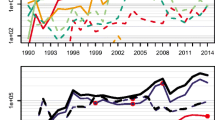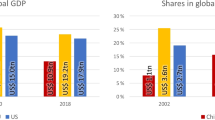Abstract—
The article analyzes the apparent consumption of copper in the United States, as well as the accumulated stocks of copper in the composition of finished goods in the economy for the period from 1900 to 2017. The analysis of apparent copper consumption is supplemented by an estimate of foreign trade in copper as part of finished goods. This allows to get a more objective assessment of the real US copper consumption from 1995 to 2017. It is shown that in the US economy it does not decrease with the transition to postindustrial development models; there is a steady increase in copper reserves in finished products.




Similar content being viewed by others
Notes
Steel Statistical Yearbooks (World Steel Association). https://worldsteel.org/steel-topics/statistics/steel-statistical-yearbook/.
UN database on foreign trade (UN Comtrade). https://comtrade.un.org/.
Website of the International Copper Association. https://copperalliance.org/policy-focus/society-economy/circular-economy/stocks-flows/.
Federal Reserve Economic Data. https://fred.stlouisfed.org/series/MANEMP#0.
REFERENCES
I. A. Budanov and V. S. Ustinov, “Features of the study of the economy using indicators of metal consumption,” EKO, No. 8, 87–109 (2020).
L. L. Zusman, Saving Ferrous Metals (Metallurgizdat, Moscow, 1958) [in Russian].
L. L. Zusman, Metal Fund of the National Economy of the USSR (Metallurgiya, Moscow, 1975) [in Russian].
S. A. Belanovskii, I. N. Borisova, A. A., Budanov, et al., A Comprehensive Program of Scientific and Technological Progress of the USSR for 1991–2010 (Akad. Nauk. SSSR, Moscow, 1988) [in Russian].
I. A. Budanov, Ferrous Metallurgy in the Russian Economy (MAKS Press, Moscow, 2002) [in Russian].
I. A. Budanov, “Relationship between metal consumption and economic development of the country,” Stal’, No. 1, 56–62 (2020).
V. L. Inozemtsev, Modern Post-Industrial Society: Nature, Contradictions, Prospects (Logos, Moscow, 2000) [in Russian].
V. L. Inozemtsev, “Fin de siécle. On the history of the formation of the post-industrial economic system (1973–2000). Article one,” Svobodnaya Mysl’—XXI, No. 7, 2–27 (1999).
A. S. Goncharenko, “The concept and essence of dematerialization of the economy,” Vestn. Sum. Derzhavn. Univ., Ser. Ekon. 2 (2), 59–65 (2008).
E. I. Naumova, “Dematerialization of capitalism: Public intellect and precariat,” Vestn. St. Peterb. Univ., Ser. Filos. Konfliktol., No. 1, 45–52 (2016).
Yu. V. Chortok and A. S. Goncharenko, “Theoretical approaches to the ecological and economic substantiation of the dematerialization of the economy,” Vneshneekon. Deyat. Obespech. Ekon. Bezop., No. 1 (2), 82–86 (2013).
O. Bernardini and R. Galli, “Dematerialization: Long-term trends in the intensity of use of materials and energy,” Futures 25 (4), 431–448 (1993).
C. J. Cleveland and M. Ruth, “Indicators of dematerialization and the materials intensity of use,” J. Ind. Ecol. 2 (3), 15–50 (1998).
B. Fix, “Dematerialization through Services: Evaluating the evidence,” BioPhys. Econ. Resour. Qual. 4 (2), 6 (2019).
B. Meyer, M. Meyer, and M. Distelkamp, “Modeling green growth and resource efficiency: New results,” Miner. Econ. 24 (2), 145–154 (2012).
E. Naumova, “Dematerialization of capitalism: A new understanding of social intelligence,” Filos. Al’tern. 27 (3), 20–28 (2018).
I. K. Wernick, et al., “Materialization and dematerialization: Measures and trends,” Daedalus 125 (3), 171–198 (1996).
R. Hannesson, “Are we seeing dematerialization of world GDP?,” Biophys. Econ. Sustainability 6 (2), 4 (2021).
W. Chen, M. Wang, and X. Li, “Analysis of Copper Flows in the United States: 1975–2012,” Resour., Conserv. Recycl. 111, 67–76 (2016).
M. Wang et al., “Analysis of the quantity and average age of copper in-use stock in the U.S. from 1985 to 2014,” Preprint no. 2017050213 (2017). https://doi.org/10.20944/preprints201705.0213.v2
M. Gorman and D. Dzombak, “Stocks and flows of copper in the U.S.: Analysis of circularity 1970–2015 and potential for increased recovery,” Resour., Conserv. Recycl. 153, 104542 (2020).
E. L. Davydenko and M. V. Grichik, “Global value chains: Theoretical and practical aspects,” Bank. Vestn., No. 4, 22–27 (2014|).
G. Gereffi, J. Humphrey, R. Kaplinsky, et al., “Introduction: Globalisation, value chains and development, IDS Bull. 32 (3), 1–8 (2001).
V. Hernández and T. Pedersen, “Global value chain configuration: A review and research agenda,” Bus. Res. Q. 20 (2), 137–150 (2017).
T. D. Kelly and G. R. Matos, Historical Statistics for Mineral and Material Commodities in the United States, U.S. Geological Survey. https://www.usgs.gov/centers/national-minerals-information-center/historical-statistics-mineral-and-material-commodities.
F. Passarini et al., “Material flow analysis of aluminium, copper, and iron in the EU-28,” in JRC Technical Reports (Publications Office of the European Union, Luxembourg, 2018).
M. Ruhrberg, “Assessing the recycling efficiency of copper from end-of-life products in Western Europe,” Resour., Conserv. Recycl. 48, 141–165 (2006).
M. Wang, et al., “Dynamic analysis of copper consumption, in-use stocks and scrap generation in different sectors in the U.S. 1900–2016,” Resour., Conserv. Recycl. 139, 140–149 (2018).
A. Yoshimura and Y. Matsuno, “Dynamic material flow analysis and forecast of copper in global-scale: Considering the difference of recovery potential between copper and copper alloy,” Mater. Trans. 59, 989–998 (2018).
Author information
Authors and Affiliations
Corresponding author
Ethics declarations
The authors declare that they have no conflicts of interest.
Rights and permissions
About this article
Cite this article
Emel’yanov, A.A., Kelchevskaya, N.R., Popova, K.A. et al. Long-Term Trends in Real Consumption of Copper in the United States. Stud. Russ. Econ. Dev. 34, 618–626 (2023). https://doi.org/10.1134/S1075700723050064
Received:
Revised:
Accepted:
Published:
Issue Date:
DOI: https://doi.org/10.1134/S1075700723050064




